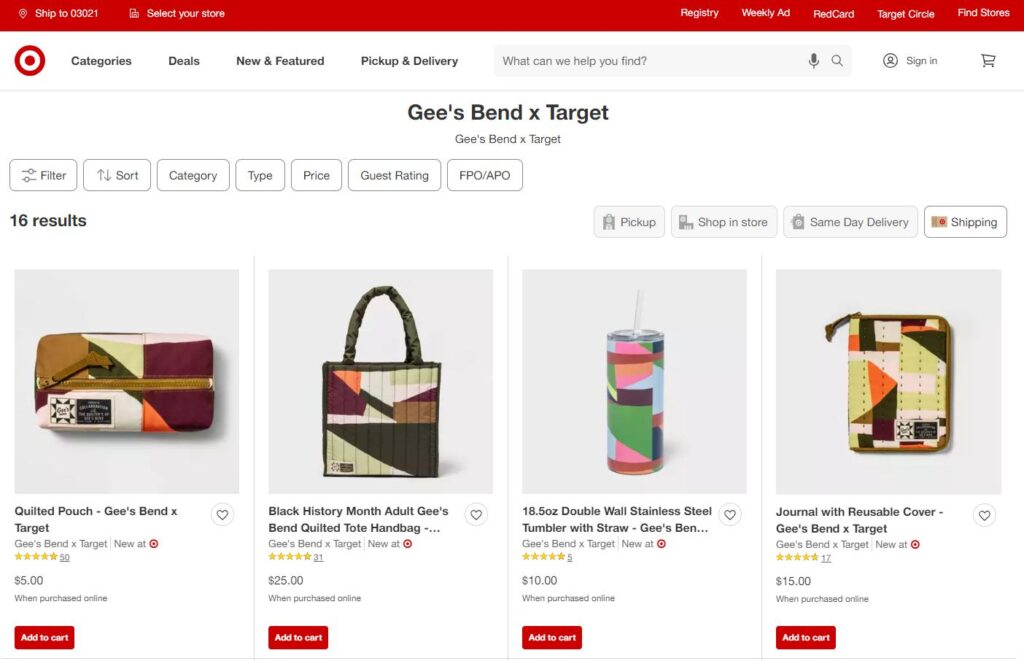
While an accessible range of craft products for the mass market is good in principle, it shouldn’t hide how it was produced.
There’s much to celebrate in the new Gee’s Bend range of products offered by Target. The iconic quilting tradition developed in Alabama by descendants of slaves has inspired a range of accessories as part of Black History Month in the USA. The website contains profiles of quilters who keep this tradition alive.
The products themselves are very affordable. What had become the domain of elite collectors is now available for a mass market. You can purchase a throw pillow for $20, a blanket for $40 and a stylist quilted jacket for an incredible $35. There are Gee’s Bend pouches, handbags, journal covers, tumblers, coasters, hoodies and t-shirts.
These items reflect the value of “living craft” celebrated on the Garland platform. This is about the role of handmade objects that enrich our everyday lives. As the New York Times article writes,
Gee’s Bend x Target Black History Month Collaboration | The Strategist, “now you can buy throw blankets and cushions at Target that you can actually use instead of displaying as artwork or keeping as an heirloom.”
The Target collection was developed by Nest, an impressive not-for-profit organisation that seeks to improve artisan livelihood. It was founded by Rebecca van Bergen, who herself grew up in a family of quilters.
“The acclaimed Gee’s Bend Quilters have long garnered praise for their bespoke offerings. Our work with these artists speaks to our mission to build a new handworker economy that benefits a wide diversity of makers and artists with greater social equity and economic opportunity.”
Given the prices, it is clear that these items were not made by the quilters themselves. Usually, larger bedspreads can sell for up to $5,000 and more artistic quilts for $85,000. Rather than “made by” quilters, the language is “designed” and “inspired” by.
So who made them? Good question. There is no information about their production. Presumably, they are produced by Target themselves through their 4,947 factories located throughout the world. My inquiry to Nest was forwarded to Target who have not replied.
The absence of this information was noted by commenters on Nest’s Instagram post. It’s a disarming mixture of opposite responses.
View this post on Instagram
While @emina.lately exclaims “Wow gorgeous! Love it!”, @stitchandyarn questions “A quilt for $40!! And a jacket for $35? What other POC’s slave labour produced these at this price?”
Cheap products that tell the story of Gee’s Bend are not inherently bad. It’s similar to buying a Monet t-shirt at a gallery store and some of the profit goes to the quilters themselves. However, the absence of production information betrays the value of the handmade. What appears quilted and handsewn is machine printed and sewn.
As AI disembodies information, craft commodification deprives us of the connection we get when using a handmade product. Craft capitalism privileges economy over authenticity. Etsy took a similar path when it changed its guidelines to allow for outsourcing.
This is not to deny the challenge we face with the growing elitism of craft products. Brands like Hermes market craft as exclusive, such as the $10,000 Birken Bag that takes up to 25 hours to stitch by hand. But there are examples of affordable handmade products such as the Rebozo Chal flower shawl from Chiapas at $70.
Outsourcing can become a feature. Better World Art takes designs from a remote Aboriginal community and commissions artisans in Kashmir to produce cushion covers. This is all part of the story.
We need to keep asking, “Who made it?”

